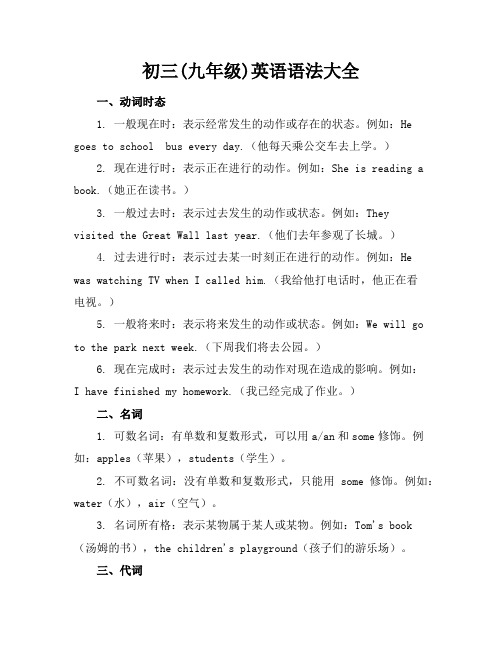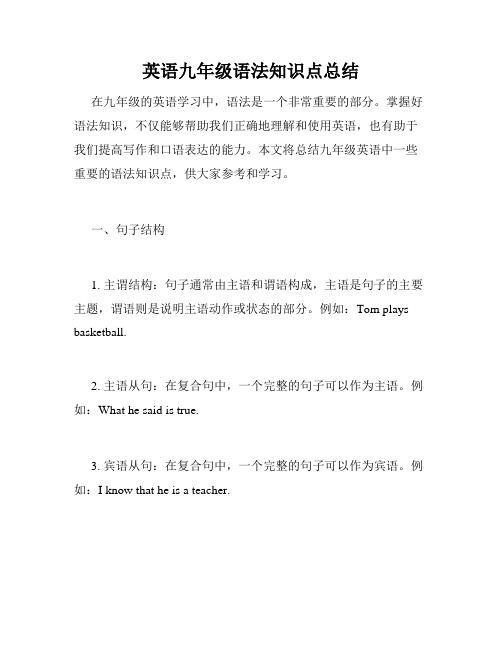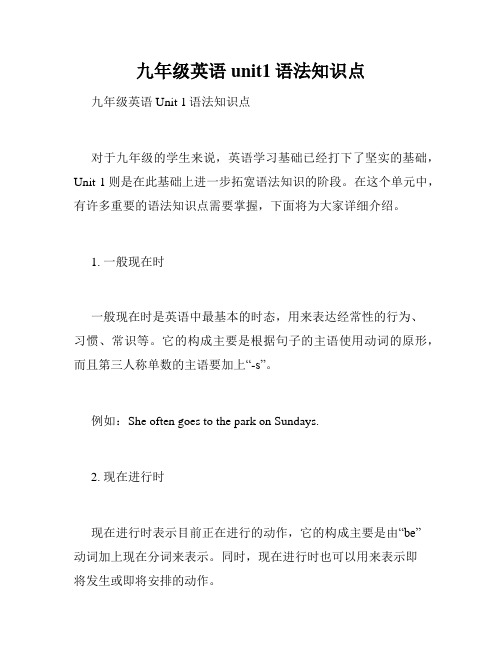九年级英语语法讲解
初三(九年级)英语语法大全

初三(九年级)英语语法大全一、动词时态1. 一般现在时:表示经常发生的动作或存在的状态。
例如:He goes to school bus every day.(他每天乘公交车去上学。
)2. 现在进行时:表示正在进行的动作。
例如:She is reading a book.(她正在读书。
)3. 一般过去时:表示过去发生的动作或状态。
例如:Theyvisited the Great Wall last year.(他们去年参观了长城。
)4. 过去进行时:表示过去某一时刻正在进行的动作。
例如:He was watching TV when I called him.(我给他打电话时,他正在看电视。
)5. 一般将来时:表示将来发生的动作或状态。
例如:We will go to the park next week.(下周我们将去公园。
)6. 现在完成时:表示过去发生的动作对现在造成的影响。
例如:I have finished my homework.(我已经完成了作业。
)二、名词1. 可数名词:有单数和复数形式,可以用a/an和some修饰。
例如:apples(苹果),students(学生)。
2. 不可数名词:没有单数和复数形式,只能用some修饰。
例如:water(水),air(空气)。
3. 名词所有格:表示某物属于某人或某物。
例如:Tom's book(汤姆的书),the children's playground(孩子们的游乐场)。
三、代词1. 人称代词:I(我),you(你/你们),he(他),she(她),it(它),we(我们),they(他们)。
2. 物主代词:my(我的),your(你的/你们的),his(他的),her(她的),its(它的),our(我们的),their(他们的)。
3. 指示代词:this(这个),that(那个),these(这些),those(那些)。
九年级英语语法知识点

九年级英语语法知识点英语语法是英语学习中非常重要的一部分,掌握好语法知识对于学习英语的同学来说至关重要。
在九年级的英语学习中,有一些常见的语法知识点需要我们掌握,下面就来一一介绍。
1. 时态:时态是英语中非常重要且常用的语法知识点。
英语根据动作发生的时间来使用不同的时态。
常见的时态有一般现在时、一般过去时、一般将来时等。
掌握好不同时态的用法,能够帮助我们准确地表达动作的发生时间。
2. 语态:语态是描述动作的主语和谓语之间关系的一种特殊的动词形式。
英语中有主动语态和被动语态两种形式。
掌握好不同语态的用法,能够让我们灵活运用英语,使表达更加准确和清晰。
3. 从句:从句是由连接词引导的,并作为句子的一部分的句子。
根据从句与主句之间的关系,从句可分为名词性从句、定语从句和状语从句。
掌握好不同从句的结构和用法,能够帮助我们用丰富的表达方式来组织句子,使表达更加地道和自然。
4. 词性:英语中的词性包括名词、代词、动词、形容词、副词、介词、连词和感叹词等。
不同的词性在句子中扮演不同的角色,掌握好词性的用法和特点,有助于我们正确理解和使用单词。
5. 语气:语气是指说话人在话语中所表现出的感情色彩。
英语中有陈述语气、疑问语气、祈使语气和感叹语气等。
适当运用语气可以让我们的表达更生动、有力和恰当。
6. 介词:介词在英语中起着连接词和词组的作用,用于表达时间、地点、方式、原因等关系。
掌握好常用介词的意义和用法,能够帮助我们在句子中准确地表达各种关系。
7. 修饰语的位置:修饰语是指在句子中对名词、代词进行修饰或限制的词组。
在英语中,修饰语的位置相对固定,通常放在被修饰的名词或代词之前。
了解修饰语的位置,可以帮助我们更好地理解句子的结构和意思。
以上是九年级英语学习中常见的一些语法知识点,它们在我们的学习中扮演着重要的角色。
掌握好这些知识点,不仅能够提高我们的英语水平,还能够让我们的表达更加地道和准确。
在学习英语语法的过程中,我们可以通过大量的阅读和练习来提高自己的能力,同时也可以向老师和同学请教,互相学习和交流。
英语九年级语法知识点总结

英语九年级语法知识点总结在九年级的英语学习中,语法是一个非常重要的部分。
掌握好语法知识,不仅能够帮助我们正确地理解和使用英语,也有助于我们提高写作和口语表达的能力。
本文将总结九年级英语中一些重要的语法知识点,供大家参考和学习。
一、句子结构1. 主谓结构:句子通常由主语和谓语构成,主语是句子的主要主题,谓语则是说明主语动作或状态的部分。
例如:Tom plays basketball.2. 主语从句:在复合句中,一个完整的句子可以作为主语。
例如:What he said is true.3. 宾语从句:在复合句中,一个完整的句子可以作为宾语。
例如:I know that he is a teacher.4. 定语从句:在复合句中,一个完整的句子可以作为定语来修饰名词。
例如:The book that I borrowed from the library is very interesting.5. 状语从句:在复合句中,一个完整的句子可以作为状语来修饰动词、形容词或副词。
例如:I will go swimming if the weather is good.二、时态和语态1. 一般现在时:用于描述经常性的动作、习惯或客观事实。
例如:He often plays basketball.2. 现在进行时:用于表示现在正在进行的动作。
例如:I am reading a book now.3. 一般过去时:用于描述过去发生的动作或状态。
例如:She watched a movie last night.4. 过去进行时:用于表示过去某一时刻正在进行的动作。
例如:They were playing football when it started raining.5. 将来时态:表示将来要发生的动作或状态。
例如:We will have a party next weekend.6. 被动语态:表示动作发生的对象是句子的主语。
英语九年级语法知识点

英语九年级语法知识点一、主谓一致主谓一致是指主语与谓语在人称和数上保持一致。
具体规则如下:1. 一般情况下,主谓一致遵循以下原则:a. 单数主语用单数谓语动词,如:The dog barks.(这只狗叫唤。
)b. 复数主语用复数谓语动词,如:The dogs bark.(这些狗叫唤。
)2. 当主语是以each,every,either,neither,one of等词开头时,谓语动词要用单数形式,如:Each student has a book.(每个学生都有一本书。
)3. 当主语是复数且由and连接的两个或两个以上的部分构成时,谓语动词要用复数形式,如:Tom and Lisa work together.(汤姆和丽莎一起工作。
)4. 当主语是并列名词,中间有or,nor,either...or,neither...nor连接时,谓语动词与靠近的主语保持一致,如:Neither David nor his friends are coming to the party.(大卫和他的朋友都不来参加派对。
)二、时态时态是表示动作或状态发生时间的一种语法形式。
常见的英语时态有以下几种:1. 现在时:表示当前的动作或状态。
a. 现在简单时:经常性或习惯性动作,或者现在的真理、规律等。
如:I play basketball every Sunday.(我每个星期天打篮球。
)b. 现在进行时:表示目前正在进行的动作。
如:They are watching a movie.(他们正在看电影。
)c. 现在完成时:表示过去发生但对现在产生影响的动作。
如:She has already done her homework.(她已经完成作业了。
)2. 过去时:表示过去的动作或状态。
a. 过去简单时:表示在过去某个时间发生的动作。
如:I finished my project last night.(昨晚我完成了我的项目。
九年级英语语法知识点归纳总结

九年级英语语法知识点归纳总结一、宾语从句宾语从句在复合句中作主句的宾语。
三大考点:引导词、时态和语序。
其中,语序必须是陈述句语序。
1. 常由下面的一些词引导:①由that 引导,表示陈述意义,that可省略He says (that) he is at home. 他说他在家里。
②由if , whether引导,表示一般疑问意义(带有是否、已否、对否等)I don’t know if / whether Wei Hua likes fish. 我不知道韦华是否喜欢鱼。
③由连接代词、连接副词(疑问词) 引导,表示特殊疑问意义Do you know what he wants to buy? 你知道他想要买什么吗?2. 从句时态要与主句一致当主句是一般现在时,从句根据情况使用任何时态当主句是一般过去时,从句应使用过去某时态(一般过去时,过去进行时,过去将来时,过去完成时)He said (that) he was at home. 他说他在家里。
I didn’t know that she was singing now. 我不知道她正在唱歌。
She wanted to know if I had finished m homewor k. 她想要知道我是否已经完成了我的作业。
Did you know when he would be back? 你知道他什么时候会回来吗?二、感叹句感叹句是表达喜、怒、哀、乐以及惊奇、惊讶等强烈感情的句子。
感叹句通常由what 或how 引导。
现分述如下:1. 由what 引导的感叹句,其句子结构可分为以下三种:①可用句型:“What +a / an+形容词+可数名词单数+主语+谓语+其他!”。
如:What a nice present it is! 它是一件多么好的礼物啊!②可用句型:“What+形容词+可数名词复数+主语+谓语+其他!”。
如:What beautiful flowers they are! 多么漂亮的花啊!③可用句型:“What +形容词+不可数名词+主语+谓语+其他!”如:What fine weather it is today! 今天天气多好啊!2. 由how 引导的感叹句,其句子结构也分为三种:①可用句型:“How +形容词/ 副词+主语+谓语+其他!”。
九年级英语unit1语法知识点

九年级英语unit1语法知识点九年级英语Unit 1语法知识点对于九年级的学生来说,英语学习基础已经打下了坚实的基础,Unit 1则是在此基础上进一步拓宽语法知识的阶段。
在这个单元中,有许多重要的语法知识点需要掌握,下面将为大家详细介绍。
1. 一般现在时一般现在时是英语中最基本的时态,用来表达经常性的行为、习惯、常识等。
它的构成主要是根据句子的主语使用动词的原形,而且第三人称单数的主语要加上“-s”。
例如:She often goes to the park on Sundays.2. 现在进行时现在进行时表示目前正在进行的动作,它的构成主要是由“be”动词加上现在分词来表示。
同时,现在进行时也可以用来表示即将发生或即将安排的动作。
例如:He is studying English in the library.3. 一般过去时一般过去时用来表示过去发生的动作或存在的状态。
它的构成主要是根据句子的主语使用动词的过去式,同时肯定句中要使用助动词“did”。
例如:They visited their grandparents last weekend.4. 过去进行时过去进行时表示在过去某个时间段正在进行的动作。
它的构成主要是由“was/were”动词加上现在分词来表示。
例如:I was watching TV when he called me.5. 一般将来时一般将来时主要用来表达将来的动作或事情。
它的构成主要是由“will/shall”加上动词原形来表示。
例如:We will have a picnic next Sunday.6. 情态动词情态动词可以用来表达能力、可能性、推测以及许可等。
常见的情态动词有can、may、must、shall、will等。
值得注意的是,情态动词后面的动词使用原形。
例如:You must finish your homework.7. 句型及从句九年级的学生还需要学习掌握一些常见的句型和从句的用法。
仁爱九年级英语语法解析(共35张PPT)
e.g. Have you finished your homework already? 难道你已经完成作业了?
2.ever 和 never ever“曾经”(多用于疑问句,问初次经历) e.g. I have ever been abroad. 我曾出过国。 never“从未;从来不”(多用于否定陈述句),常回答 ever的句型。 e.g. I have never seen him before. 我以前从没见过他。 —Has he ever been abroad? 他曾出过国吗? —No, never. 不,从来不。
我的家乡发生了很大的变化。
⑵否定式:“主语+have/has + not +动词的过去分词” e.g. I haven’t seen him for a long time. 我很久没见到他了。 ⑶一般疑问式:“助动词have/ has +主语+动词的过去分 词?”
肯定回答:Yes, 主语+助动词have/has 否定回答:No, 主语+助动词have/has +not e.g. —Have you ever watched a movie in the open air?
(强调的是格林先生买新电脑的时间是昨天)
2. 时间状语不同。 现在完成时常与already, yet, just, ever, never, before等 副词以及“for+一段时间”,“since+过去时间/句子” 等时 间状语连用;而一般过去时则常与“一段时间+ago”,just now, yesterday, last week等表示过去时间的状语连用。 e.g. _S_h_e_h_a_s__li_v_e_d_h_e_r_e since two years ago. 她两年前就住在这里了。 _S_h_e_l_iv_e_d__h_e_re_ two years ago. 两年前她住在这里。 _H_e__h_as__b_e_en__i_n the League for three years. 他入团已经三年了。 _T_o_m__w_r_o_t_e_a_l_e_t_te_r to his parents last night. 昨晚汤姆给他的父母写了一封信。
九年级英语语法知识点大全
九年级英语语法知识点大全一、词汇类语法知识点1. 名词名词是表示人、事物、地点、抽象概念等的词语,常用于句子的主语、宾语等。
名词有可数和不可数两种形式。
2. 代词代词是用来代替名词的词语,分为人称代词、物主代词、指示代词、反身代词等。
3. 形容词形容词用来修饰名词或代词,表示其性质、特征、状态等。
4. 副词副词用来修饰动词、形容词、其他副词或整个句子,表示时间、地点、方式、程度等。
5. 动词动词是表示动作、状态或存在的词语,句子中常充当谓语动词,用于构成句子的基本谓语。
二、句子结构类语法知识点1. 主谓一致主谓一致是指主语与谓语动词在人称和数上保持一致。
2. 宾语宾语是及物动词的必要成分,它接在动词后面,说明动作的承受者或影响对象。
3. 宾语从句宾语从句是充当动词宾语的一个完整句子,具有主语、谓语和宾语从句中的其他成分。
4. 主语从句主语从句是充当主语的一个完整句子,它位于句子的主语位置。
5. 定语从句定语从句是充当名词的修饰语,一般由关系词引导,限定或修饰名词的性质、特征等。
6. 状语从句状语从句是充当状语的一个完整句子,它表示时间、原因、条件、目的等。
三、时态与语态类语法知识点1. 一般现在时表达经常性、习惯性动作或真理时使用的时态。
2. 现在进行时表示现阶段正在进行的动作。
3. 一般过去时表达过去某个时间发生的动作或存在的状态。
4. 过去进行时表示在过去某一时间或动作进行时。
5. 一般将来时用于表示将来某一时间或将要发生的动作。
6. 被动语态将动作的承受者放在句子的主语位置,强调动作的承受者。
四、语法规则类语法知识点1. 比较级与最高级用来比较两个或多个人或物在某一方面的差别。
2. 直接引语与间接引语直接引语是直接引述他人的话语,要用引号包围;间接引语是用自己的话转述他人的话。
3. 倒装句将助动词、情态动词或表地点、方式的副词放在主语之前,构成倒装句。
4. 并列连词用于连接两个意义相同或相近的词、短语或句子。
九年级英语语法知识点归纳总结
千里之行,始于足下。
九年级英语语法知识点归纳总结九年级英语常见语法知识点归纳总结:1. 时态- 一般现在时:表示经常性、习惯性的动作或状态。
- 现在进行时:表示现在正在进行的动作。
- 一般过去时:表示过去发生的动作或状态。
- 过去进行时:表示过去某个时间正在进行的动作。
- 现在完成时:表示过去发生的动作对现在造成的影响或结果。
- 过去完成时:表示过去某个时间前已经完成的动作。
2. 被动语态- 主动语态转被动语态:将主动语态的动词改为相应的被动语态的形式,同时将句子的主语变为动作的承受者。
- 被动语态的构成:be (am, is, are, was, were) + 过去分词。
3. 物主代词- 形容词性物主代词:my, your, his, her, its, our, their。
- 名词性物主代词:mine, yours, his, hers, its, ours, theirs。
4. 直接引语和间接引语- 直接引语:直接引用别人的原话。
- 间接引语:将别人的原话转述为间接引语,常常使用that,或在某些情况下省略that。
5. 倒装句- 完全倒装句:将助动词、情态动词或be动词提到主语前面。
第1页/共2页锲而不舍,金石可镂。
- 部分倒装句:将助动词或be动词提到动词前面。
6. 从句- 名词性从句:在句子中充当名词的成分。
- 定语从句:在句子中充当定语的成分。
- 状语从句:在句子中充当状语的成分。
7. 并列连词和从属连词- 并列连词:连接意义相同的并列分句,如and, but, or, so等。
- 从属连词:连接主句与从句,如if, when, because, although等。
以上是九年级英语常见的语法知识点总结,希望能对你有所帮助!。
英语九年级全一册语法.doc
英语九年级全一册语法九年级语法学不会?太难掌握?来参考一下我整理收集的语法知识吧。
一起来学习吧英语九年级全一册语法【1】1. what a great day! 多么美好的一天!what fun the water festival is!泼水节是多么有趣啊!how fantastic the dragon boat teams were!那些龙舟队真棒极了!【解析】感叹句一、结构:what (a / an) + adj. + n. + 主+ 谓!how + adj. / adv. +主+ 谓!what beautiful flowers they are !二、what引导的感叹句:1.what + a / an +adj + 单数名词(+主语+ 谓语)!what a nice day (it is)!what an interesting game (they are playing)!2. what + adj + 复数名词(+主语+ 谓语)!what wonderful photos (they are)!what kind people (they are)!3. what + adj + 不可数名词(+主语+ 谓语)!_______ bad weather (it is)!what nice food (he cooks)!三、how引导的感叹句:1.how + adj / adv + 主语+ 谓语!how nice he is!how beautiful the flowers are!2.how + adj + a / an + 单数名词(+主语+ 谓语)!how tall a boy (he is )!how nice a song (she is singing)!3.how + adj / adv + the + 名词+ 谓语!how tall the boy is!how fine the day is!4、what 与how引导的感叹句之间的转换:1.what a beautiful girl she is != ______ beautiful the girl is !2.how delicious the food is != ______ delicious food it is !2.the dragon boat festival in hong kong 香港龙舟节【解析】介词in表地点in用于较大的地点前,如大城市、国家、洲等。
- 1、下载文档前请自行甄别文档内容的完整性,平台不提供额外的编辑、内容补充、找答案等附加服务。
- 2、"仅部分预览"的文档,不可在线预览部分如存在完整性等问题,可反馈申请退款(可完整预览的文档不适用该条件!)。
- 3、如文档侵犯您的权益,请联系客服反馈,我们会尽快为您处理(人工客服工作时间:9:00-18:30)。
九年级英语复习---语法讲解(1-7单元)Unit1By是个很常用的介词(有时也用作副词),在初中英语中的用法有以下几种:1.意为“在……旁”、“靠近”。
如:Some are singing and dancing under a big tree . Some are drawing by the lake.有的在大树下唱歌跳舞,有的在湖边画画儿。
2.意为“不迟于”、“到……时为止”。
如:Your son will be all right by supper time. 你的儿子在晚饭前会好的。
How many English songs had you learned by the end of last term?到上个学期末你们已经学了多少首英语歌曲?3.表示方法、手段,可译作“靠”、“用”、“凭借”、“通过”、“乘坐”等。
如:The monkey was hanging from the tree by his tail and laughing.猴子用尾巴吊在树上哈哈大笑。
The boy’s father was so thankful that h e taught Edison how to send messages by railway telegraph.孩子的父亲是那么的感激,于是他教爱迪生怎样通过铁路电报来传达信息。
4.表示“逐个”、“逐批”的意思。
如:One by one they went past the table in the dark.他们一个一个得在黑暗中经过这张桌子。
5.表示“根据”、“按照”的意思。
如:What time is it by your watch? 你的表几点了?6.和take , hold等动词连用,说明接触身体的某一部分。
如:I took him by the hand. 我拉住了它的手。
7.用于被动句中,表示行为主体,常译作“被”、“由”等。
如:English is spoken by many people. 英语被许多人所说。
(即“许多人讲英语。
”)8.组成其它短语。
1) by the way : 意为“顺便说”、“顺便问一下”,常做插入语。
如:By the way , where’s Li Ping , do you know?顺便问一下,李平在哪儿。
你知道吗?2) by oneself : 意为“单独”、“自行”。
如:I can’t leave her by herself. 我不能把她单独留下。
3) by and by : 意为“不久以后”、“不一会儿”。
如:But by and by , more and more people began to study English.但是不久以后,越来越多的人开始学英语了。
二、动名词的构成动词后加动名词doing,相当于名词,在句子中可以做主语、宾语、表语定语等。
1)★作主语(这种用法常考)Fighting broke out between the South and the North.南方与北方开战了。
2)作宾语Would you mind turning down your radio a little, please?请问你介意调小一点收音机的音量吗?3)作表语Babysister’s job is washing,cooking and taking care of the children。
保姆的工作是洗衣服,作饭和照看孩子。
Unit2used to 的用法:(1)肯定句:used这个词没有人称的变化,to后面接动词原形。
否定句是didn’t use to….When I was a child, I didn’t use to like apples.当我还是孩子的时候我不喜欢苹果.疑问形式是D id you use to…?Where did you use to live before you came here?当你来这儿之前你住哪儿?(2)含有used to 的句子的反意疑问句不要usedn’t + 主语,而用didn’t +主语。
He used to smoke, didn’t he?他过去常常吸烟,是吗?Yes, he did./ No, he didn’t. 是的,他吸。
/ 不,他不吸。
(3)used to 表示过去的习惯动作,而不是现在的。
I am used to the weather here. 我已经习惯于这里的天气了。
He is used to hard work. 他习惯于艰苦的工作。
(4)used to 可以和be, have 以及其他状态动词连用,描写过去的状态。
I used to be a waiter, but now I’m a taxi-driver.我过去是一个服务员,但现在我是出租车司机。
★本单元的许多运用used to 的句子属于描述过去的状态。
Mario used to be short.马力奥过去总是很矮。
Amy used to be outgoing.爱米过去性格外向。
Tina used to have long and straight hair.蒂娜过去有一头直的长头发。
He used to wear black shoes. 他过去常穿黑鞋。
Unit3本单元重点讲到了被动语态的用法英语动词的被动语态由助动词be加及物动词的过去分词构成。
助动词be有时态,人称和数的变化,其变化规则与连系动词be完全一样。
一、被动语态的句式变化:以一般现在时和动词invite为例,列表说明被动语态的句式变化:二、各种时态的被动语态结构总结如下:被动语态的时态是由be的时态决定的,be是什么时态,全句就是什么时态,be 动词后面的过去分词不变。
一般现在时的被动语态为:主+am / is / are (not)+过去分词一般过去时的被动语态为:主+was / were +过去分词例如:我们学过的was / were born 生于,就是一个被动语态.born是个过去分词(bear)-When were you born ? -I was born in 1989.现在进行时被动语态的构成为: 主语+is / am / are + being +过去分词现在完成时被动语态的构成为: 主语+have / has +been +过去分词情态动词的被动语态: 情态动词+be+过去分词一般将来时的被动语态: 主语+will +be +过去分词过去将来时的被动语态: 主语+would / should + be +过去分词过去进行时的被动语态: 主语+was / were + being +过去分词过去完成时的被动语态: 主语+had + been +过去分词三、被动语态的用法:(1)不知道或没有必要说明动作的执行者是谁,不用by+动作执行者短语Football is played widely all over the world. 全世界都广泛地踢足球。
(2)强调动作的承受者,这时应用by短语。
The bank was robbed yesterday afternoon. 昨天下午这家银行遭到抢劫。
(3)作客观说明时,常采用一种被动语态句型It is reported that about twenty children have died of flu in the USA.据报道美国大约二十名儿童死于流感。
四、主动语态的句子变为被动语态的方法是:(1)把原句中的宾语变为主语(2)动词改为被动形式,即be+过去分词(3)原来的主语,如果需要的话,放在by后面,如果没必要,可省略。
请看下表:Unit4虚拟语气:如果我们所说的不是事实,也不是要求、命令、劝告等,而只是一种假设、愿望、建议或是一种实现不了的空想就用虚拟语气注意:条件句分两种,真实条件句和虚拟条件句。
只有在虚拟(非真实)条件句中,才用虚拟语气,而在真实条件句中,要用陈述语气。
请比较:(1)If it is sunny tomorrow , we’ll go to the zoo.如果明天天气好,我们将会去公园。
在这句话中,明天天气好是完全有可能实现的,并非虚拟、幻想,因此是真实条件句。
在本句中,适用“主将从现。
”(2)If I were you , I would go at once.(如果我是你的话,我立刻就走。
)在这句话中,条件句,“如果我是你”,但事实上,我不可能成为你,这只是假设的情况,没有实现的可能。
当条件实现的可能性很小,甚至可以说没有时,就需要用虚拟语气来表示,动词发生了变化。
也就是说虚拟语气表示和现实的事实相反时,从句用一般过时。
主句用“should/would/could/ might +动词原形。
1.If I had time, I would go for a walk.2.If I were invited, I would go to the dinner party.3.If I won a million dollars in the lottery, I would put it in the bank.知识点2. He doesn’t know if he should bring a present.此处if表示“是否”,引导宾语从句。
Should此处表示“应该”。
不是虚拟语气。
E.g.1. I don’t know if I should go to the party.2.If I have enough money, I will go to Hainan .知识点3.If I were you , I’d wear a shirt and tie.if 引导的条件状语从句表示与现在事实相反的虚拟语气时,be动词只能用were,而不能用was。
E.g. If he were here, he would not agree with you .知识点4. I don’t have a present. What if everyone else brings a present?What if… “如果……怎么办?”相当于what would happe n if…E.g. What shall I do if it snows?知识点5.Well, dogs can be a lot of trouble.Trouble 麻烦事,名词常用搭配:get (sb)into trouble get out of trouble what’s the trouble“if”引导的条件句。
